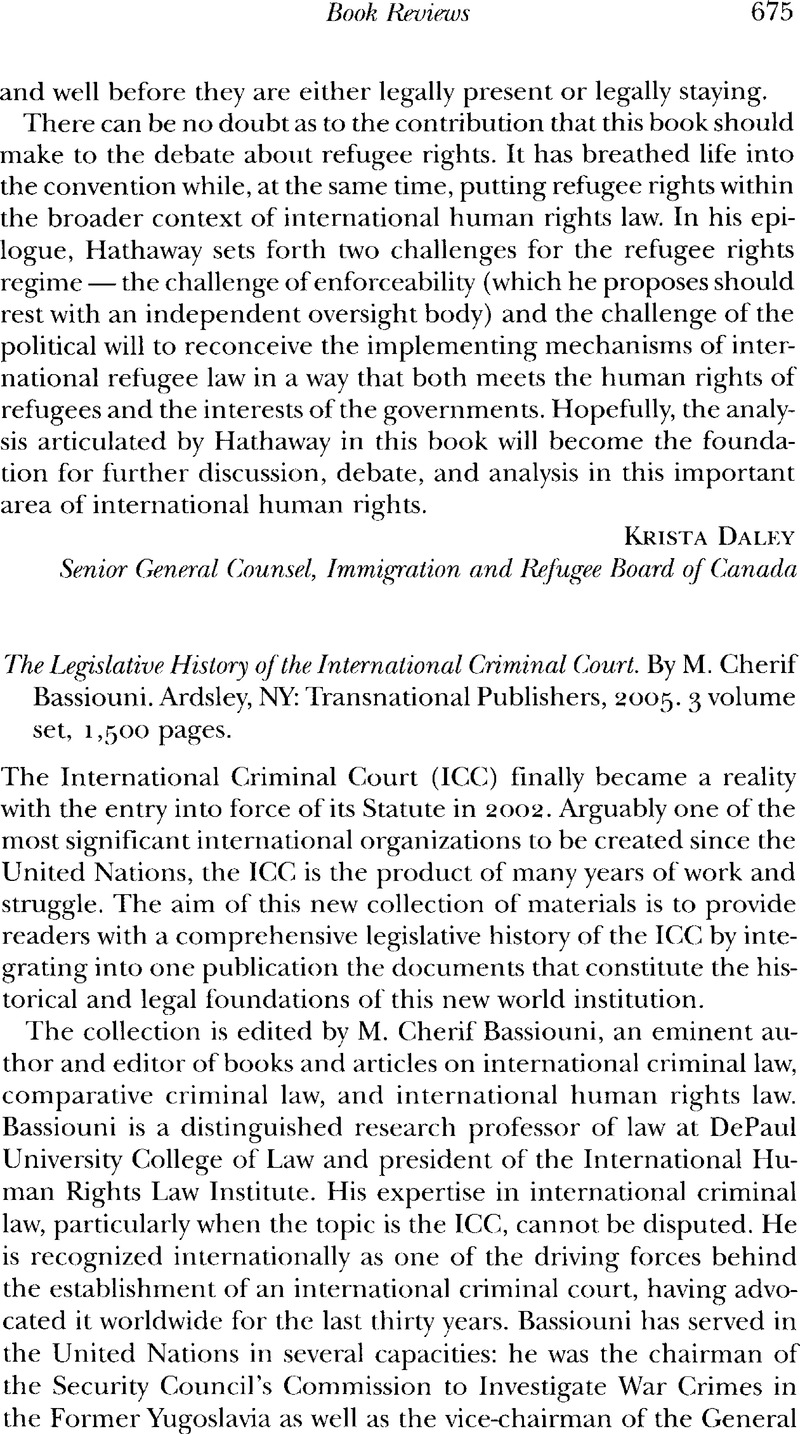No CrossRef data available.
Article contents
The Legislative History of the International Criminal Court. By Cherif Bassiouni. Ardsley, NY: Transnational Publishers, 2005. 3 Volume set, 1,500pages.
Published online by Cambridge University Press: 09 March 2016
Abstract

- Type
- Book Reviews / Recensions de livres
- Information
- Canadian Yearbook of International Law/Annuaire canadien de droit international , Volume 43 , 2006 , pp. 675 - 681
- Copyright
- Copyright © The Canadian Council on International Law / Conseil Canadien de Droit International, representing the Board of Editors, Canadian Yearbook of International Law / Comité de Rédaction, Annuaire Canadien de Droit International 2006
References
1 Bassiouni, M. Oherif, The Legislative History of the International Criminal Court: Introduction, Analysis and Integrated Text (Ardsley, NY: Transnational Publishers, 2005) at xix.Google Scholar
2 Ibid.
3 Ibid. at 84–85.
4 Ibid. at 120.
5 For example, Bassiouni inserts his views on the failure to include social and political groups in the definition of genocide — a position for which he advocated strongly before and during the conference. In his view, “[t]he reason why governments in 1998 failed to include these groups within the provision of Article 6 is beyond comprehension.” Ibid. at 149.
6 Ibid, at 140.
7 Ibid.
8 Ibid. at 141. He adds: “Probably what is most shocking about resolutions 1422 and 1487 are their promotions of blanket impunity. Only those governments who have a disregard for the international rule of law coupled with the arrogance of power, and more particularly for international humanitarian law, could have led these governments to impose these two resolutions.” Ibid. at 144.
9 For example, Bassiouni shares his views on the validity of the bilateral agreements the United States has entered into with other states: “It would be absurd to propose that a state cannot extradite a non-national to another state that has a valid jurisdictional basis to prosecute the requested person.” Ibid. at 139.
10 The following list is just a sample of mistakes found in the text: (emphasis added to point out the errors):
-
•
• “It may also be intra vires, if the St abuses its authority pursuant to Article 39 of the Charter, though there is no judicial body to review the legally basis of that political determination.” Ibid. at 132.
-
•
• “In other words, if a state party resorts to such alternative mechanisms, can that state claim to have satisfied requirements of complemenarily, which pursuant to the statute are investigation and if necessary prosecution?” Ibid. at 134.
-
•
• “Unsettled issues include a state party’s inability or unwillingness to prosecute, slow or ineffective national investigations and prosecution, determination not to prosecute, judicial determination of acquittal, or judicial meeting of a symbolic sanction.” Ibid. at 138.
-
•
• “Had such an exception to the Court’s jurisdiction been formulated in connection with Articles 1 2–19, clearly express opposition to it would have occurred by most of the Diplomatic Conference’s delegation.” Ibid. at 144.
-
•
• “The Statute does not permit the states parties to ratify the Treaty with any reservations or declarations and understandings [Article 20]. It does, however, allow for amendment and reviewing of the Statutes.” Ibid. at 190.
-
•
• “[as corrected by the procès-verbaux of to November 1998 and 12 July 1999].” Ibid. at 201.
11 The index in Volume I incorrectly numbers Chapter 3 of Part I as “Chapter 2.” Ibid. at vi. There is also an incorrect referral to a document as an appendix to Chapter 2, when, in fact, it is reproduced in Volume III: “The UN, however, issued a publication (reprinted as an appendix to this chapter), which purports to be a record of the Rome Conference prepared by the Office of Legal Affairs. In time, it is likely to become the authoritative diplomatic history of the conference, faule de mieux.” Ibid. at 76. The index to Volume 2 also contains an error. It mistakenly refers to Article 12 when it means Article 112. Bassiouni, M. Cherif, The Legislative History of the International Criminal Court: An Article-By-Article Evolution of the Statute (Ardsley, NY: Transnational Publishers, 2005)Google Scholar at vi.
12 For example: “There is no doubt that only the SC or a state party can refer a “situation” to the ICC by the.” Bassiouni, supra note 1 at 132.
13 See the font of footnote 115: ibid. at 151. And the font of footnote 207: ibid. at 180.
14 Ibid. at 199.
15 For example, the following sentences could have benefited from some serious editing:
-
•
• “Lastly, with respect to the sources of the law applicable to the interpretation of Article 8, Article 10 controls, subject to Article 9, provided that Article 9 is interpreted as binding with respect to the judicial interpretation of Article 8.” Ibid. at 164.
-
•
• “Upon the Prosecutor’s motion, the Pre-Trial Chamber may issue an arrest warrant if it determines that reasonable grounds that an individual committed a crime within the ICC’s jurisdiction exist.” Ibid. at 169.
16 For example, a section relating to “unique investigative opportunity” is repeated word for word at both page 169 and 175 of Volume 1 (which led this reader to think she had unknowingly flipped the pages back to the first reference). Several other sections include similar unacknowledged repetitions.




